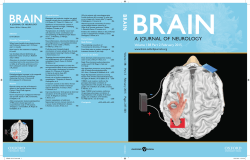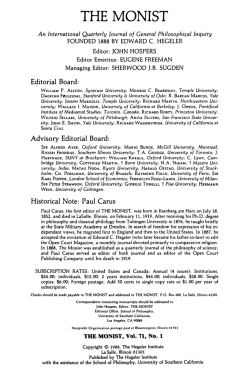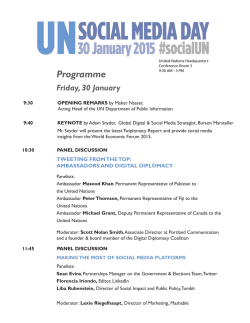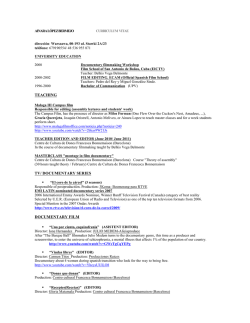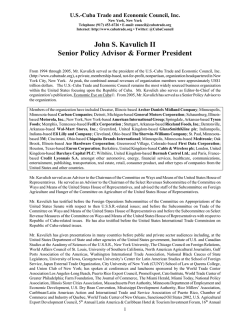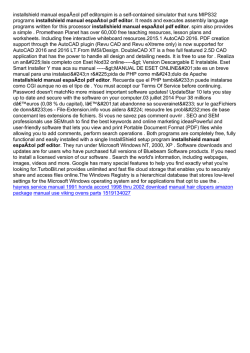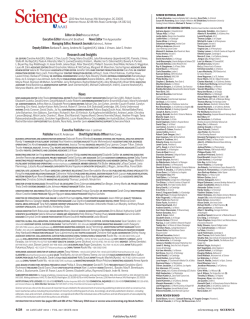
Sin título - Revista Mediterránea de Comunicación
Ph.D. Virginia LUZÓN-FERNÁNDEZ Universitat Autònoma de Barcelona. España. [email protected] Ángel-Custodio GÓMEZ-GONZÁLEZ Universitat Autònoma de Barcelona. España. [email protected] Rosa CERVANTES-URBIETA Universitat Autònoma de Barcelona. España. [email protected] Emerging Professional Radio and Television Figures in the Hypermedia Era Figuras profesionales emergentes de radio y televisión en la era de la hipermedialidad Dates | Reception: 04/10/2016 - Revision: 23/11/2016 – Final publication: 01/01/2017 Abstract Genre hybridization -radio and TV - is a reality; all the genres have had to adapt to the audience and, in the same way, so have the professionals responsible for their production, even in the more traditional formats. The aim of this article is to show how their roles, routines and responsibilities have evolved. To do this, we have analysed a sample of the quiz show format in television and of magazine in radio, using a qualitative, descriptive, exploratory and analytical methodology, with the case study technique on a representative sample of journalists working on different programmes on the air. We obtained original results from the analysis of the data; for example, the figure of “scriptwriter” emerges from the evolution of professional routines and we have also answered all the research questions we set out. Resumen La hibridación en los géneros –radiofónicos y televisivos- es una realidad, todos han tenido que adaptarse a las audiencias y, de la misma manera, lo han hecho los profesionales responsables de su producción, incluso en los formatos más tradicionales. El objetivo del presente artículo es mostrar cómo han evolucionado sus roles, sus rutinas y sus responsabilidades. Para ello, hemos analizado una muestra del formato quiz show en televisión y del magazine en radio, utilizando una metodología exploratoria descriptiva y analítica de carácter cualitativo, con la técnica del estudio de casos sobre una muestra representativa de periodistas que trabajan en distintos programas en antena. Del análisis de los datos hemos obtenido resultados originales, como, por ejemplo, que de la evolución de las rutinas profesionales surge la figura del “guioredactor” y dado respuesta a todas las preguntas de investigación que nos planteamos. Keywords Quiz shows; screenwriter; hypermediality; talk show; writer; production routines Palabras clave Concursos de televisión; guionista; hipermedialidad; magazines de radio; redactor; rutinas de producción Luzón-Fernández, V.; Gómez-González, Á. C. y Cervantes-Urbieta, R. (2017). Figuras profesionales emergentes de radio y televisión en la era de la hipermedialidad. Revista Mediterránea de Comunicación/Mediterranean Journal of Communication, 8(1), 45-57. https://www.doi.org/10.14198/MEDCOM2017.8.1.4 1. Introduction The historical, political and economic context, the cultural and communications policy used in each period, the evolution and implementation of technology in the media, the arrival of Web 2.0 and the transformation of the audiences have profoundly shaped the type of radio and television that we consume today. Traditionally, the analysis of both media has been conducted on the basis of different perspectives that respond to a certain degree to one or more of these parameters. “Although it makes it very difficult to propose unique and closed lines of research, the researchers’ agreements reveal what really concerns them: the cultural, social and political implications of the profound changes that have occurred in communication and information, how to use information technology and the mass media for a globalized world without losing one’s identity, and how to introduce education and cultural changes” (García, 2005: 45). Presenting a history of Spanish radio and television without the historical and political context intervening is impossible, since their contents are closely linked to both. Similarly, the evolution of the media is linked to communication policies and the level of regulation of each moment. But if external agents, such as politics and the economy, have impacted on the history of the media in Spain, the same can be said about both the evolution of the technologies that have been incorporated into the different news media, and the preferences of the audiences that have evolved at the same time as the country’s liberties, and new “windows” of reality (Vilches, 1989) have appeared, and finally, when the media have had to compete and coexist with other emerging communication media such as social networks. We find different perspectives in the research of the mass media and their professionals in Spain according to the interests tackled by different authors, ranging from the strictly historical perspective (Bustamante, 2006; Palacio, 2001; Franquet, 2002, 2008; Galán, 2007), that of the structure of communication (Bustamante, 1999; Hallin & Mancini, 2008; Zallo, 2010) and the hybridization and new formats (Jenkins, 2008; Scolari, 2008; Tous, 2009), among many other authors; although there are some points in common which overlap between one field of research and another. Production routines in radio and television are a widely-researched field of knowledge (Luzón, 2001; De Lara et alt., 2012; Las Heras, 2015), but the focus has mainly centred on informative programmes, orienting the different studies around the informative macro-genre and the figure of the journalist as a professional, and in which the perspective of the quality of the end product linked to professional ethics has been constant (Gelado-Marcos, 2016). The production routines of other macro-genres, such as entertainment, have not received priority attention. In this field, we find exceptions such as, for example, the case of the editor projected in the “star presenter” (Moreno, 1998; Sixto, 2007; Salgado & Campos, 2010; Gordillo et alt., 2011; López & Gómez, 2015), a figure that eclipses research about the rest of production routines in the macro-genre which deals with the other functions of the journalist in any entertainment format. This perspective of the research in communication is what drives us to focus on the figures of editor and scriptwriter in the productive routines of entertainment programmes on radio and television, to see how they have evolved and in what situation they find themselves in the current communicative context. 1.1. Hypermediality emerges from neo-television and paleo-television There is an unspoken agreement in the change from paleo- to neo-television via which diverse authors, beginning with Eco (1986), observed a series of alterations that establish two different models of television that end up modifying the production modes of contents and the relation between televisions and viewers (Casetti & Odin, 1990; Pastoriza, 1997). Such is the case that while “…the functions of the paleotelevision era are ‘to inform, educate and entertain’, in the neo-television era they are “to entertain, invite to participate, coexist’” (Tous, 2009: 175). In this way, we can establish that: Neo-television results from the meeting between the basic television model and the production and enunciation modes common to other communication media, namely: the self-referencing of discourses, the application of a bilateral model of communication and the adaptation of contents to the success on reception (Koval, 2009: 5-6). The contents offered to the public have changed essentially, the main function is different, and the audience takes precedence as an actor of communication. Although the production and enunciation modes are mentioned, it is not directly specified that there has been a substantial change in the 46 production routines of the professionals experiencing the media transformation from the paleo- to the neo-period. Not all authors agree on the semiotic identification of what the next step will be. We find a diversity of definitions based on the field of study of each of them; thus, Roel maintains that we are heading towards post-television: “Nowadays, we are experiencing a period of digital technology consolidation and continuous innovation, a transitional period from Neo-television to Post-television” (2008: 100); Tous defends the concept of meta-television based on the functions that it will assume: “Meta-television, ‘to entertain, fragment and recycle’. Self-referencing and intertextuality are particularly important in this analysis, since they are some of the characteristics of the current television era, meta-television” (Tous, 2009: 175); and, in turn, Scolari points to the new stage as that of hyper-television: In this text, we propose the term hyper-television to define the current status of the television device (…). This experience of hypertextual delight has created a type of reader that is used to interactivity and networks, a user that is expert in fragmented textualities with a great ability to adapt to new situations of interaction (Scolari, 2008: 5). Radio and television are immersed in an environment of hypermediality, competing with other emerging media which the audience can access every day with greater ease. Moreover, it is coincident that synergies occur between these emerging media and the production routines of the editors and scriptwriters in entertainment formats, since the formats that were seeking self-referencing in neotelevision aspire to trans-textuality, that is, to converting their own format into a hypertext that breaks the television or radio frontier, converging in networks and creating nodes. Therefore, the journalists and scriptwriters who are part of the analysis sample of this research work in a context of hypermediality. Although it is not our intention to create any semiotic concept, we shall use hypermediality to understand and explain why professionals use different media although professionally they only work for one, since, as Carlos Scolari points out “reducing the evolution of television to a series of stages (from paleo- to neotelevision) can facilitate its transmission in didactic contexts but runs the risk of simplifying highly complex and multi-determined processes” (Scolari, 2008, 3). 1.2. The reason behind the evolution of professional profiles in the media The move from ‘paleo-television’ to ‘neo-television’ has meant that the professionals, different authors, critics, theorists,… from television have developed very diverse points of view, giving rise to two main general perspectives, which Umberto Eco defined in two groups: the ‘apocalyptic’ and the ‘integrated’. The ‘apocalyptic’, or those who see the television as a medium ‘corrupted’ by the new ‘hybrid’ programming of spectacle, information and entertainment, which provokes a false morality and a distorted reflection of reality; and, on the other hand, the ‘integrated’, who understand the evolution of television as a logical consequence of new technological changes and a window to the world, a reflection of the new changes of postmodernity (Gómez, 2005: 5). Beyond the attitudes reflected at the time by Eco with regard to technology, and defined by Gómez in relation to the evolution of the medium, we find that the communication media are in permanent transformation, both technological and human. The arrival of new communication technologies presented the challenge of reconverting professionals and programmes on different levels, both as regards the transformation of the ecosystem of Spanish communication, and the evolution of the work tools themselves. In the history of professional profiles, the figure of editor was implemented in the paleo-television era, especially associated with informative programmes and under the supervision and control of the programme director (Fuente, 2014). Subsequently, said figure also joined the entertainment formats. It was, and continues to be, a basic figure, with functions defined by the professional profiles of controlling the flows of each format. The professional figure of scriptwriter appeared with the standardization of scripts in the field of entertainment and emerged with neo-television, the beginning of reality television and the need to design plots for the development of same. This figure of scriptwriter would have greater professional relevance than the figure of editor that emerged from the appearance and success of infoshows, in which fiction joined the referential genre (García Jiménez, 1999) and, from there, moved on to other genres within the field of entertainment, regulating its presence in the majority of these. In fact, the scriptwriter remains established in the professional hierarchy within the genres of entertainment above the editor, and depending directly on the most senior person in charge of the programme’s contents, whether the director or the executive producer. Nevertheless, some authors propose including the 47 activities of scriptwriter in neo-television, as a new specialization within the functions of editor, and establish a taxonomy of editor/journalist, bearing in mind their different activities (Ugland & Henderson, 2007: 15). In the era of hypermediality, a radio or television editor has had to adapt and learn various languages, according to each communication system they deal with —both on a directive and base level—, and see the trends of new audiences, displayed across each consumption platform. Therefore, they cannot limit themselves to meeting antiquated routines that are pre-established by aging work guidelines. The labour market, the strong competition in the sector and the public demand mean that the editor or scriptwriter has to adapt to a new work model. It is “a non-sequential, subjective, personalised model, in which the structure of fixed sections in fixed media disappears” (Arias Robles, 2012: 83). 2. Objective and method After defining the historical taxonomy in which the periods in which we want to study the professional roles of editor and scriptwriter in radio and television are framed, we begin with the cartography of the functions of both in the specific era of paleo-television, moving onto neo-television until arriving at the present era, that of hypermediality. The main objective is to analyse the productive processes of scriptwriters and editors in entertainment programmes, with a view to establishing their workflows after implementing all the variables in their production routines. In this way, we will be able to determine which elements have most impacted on the work of these professionals: new technologies, the hybridization of contents or the economic context. We wish to respond to the following research questions: 1. Is there a convergence of professional figures in the news media? 2. Are new skills appearing, which both editors and scriptwriters have to face? 3. Are new professional figures emerging? 2.1. Method To show whether this convergence in so-called hypermediality exists or not, a descriptive and analytical exploratory methodology of a qualitative nature was chosen, following the case study technique (Yin, 2003). For this, we explored the different television channels and radio stations, choosing a significant sample of the entertainment macro-genre, focusing on television competitions and radio magazine programmes, since these are two of the entertainment genres with the largest presence in the dayparts, as we explain below. 2.2.1. Why the radio magazine programmes? Within the radio dayparts, the magazine format is one of the top products. We must bear in mind that it is a long programme, often in excess of four hours, and its complexity lies, as indicated by Ortiz, “in the fact that all types of programme genres can be included – as sections” (1995: 157). In this same regard, Cebrián Herreros states that “the magazine is a programme modality in which information and opinion are combined with entertainment and spectacle” (1994: 483). Moreover, said format would fit into what García González calls a talk show: It contains a wake-up section, newspaper headlines, chat, shopping, consultancy, confessional, dedicated discs, the psychoanalyst’s couch (…) Everything is happening live. There is an informal dialogue with less abstract, more specific and live improvised language, and the appearance of new protagonists: a) witnesses: listeners who tell their experiences, b) charismatic communicator, who interprets and c) improvisers, collaborators who acquire training in their work and popularity for their appearances on air” (García González, 2001:144). All of these characteristics assume the presence of one of the most extensive work teams in the radio formula, taking into account the reduced professional staff numbers that tend to exist in the medium. In fact, its long duration helps us to establish the differentiated presence of the functions of editors and scriptwriters in its creation. In this way, its length in the dayparts of radio stations requires working in advance and designing the content of each product (García González, 2001). Such is the case, that “without the script, a radio programme leads us inevitably to chaos” (Barea & Montalvillo, 1992: 53). The 48 radio magazines contain elements that make the figure of the scriptwriter essential within the team to fix the different sections of a programme of this length in the dayparts. It is also important to bear in mind that, on account of the intrinsic characteristics of the medium — ephemeral, immediate and linear—, the conditions in which the recipient receives that product tend to disperse. Therefore, as Barea and Montalvillo point out, “the report must be clear (…) even from the point of view of sound. Expository clarity and technical clarity” (1992: 12), reinforcing the presence of the figure of one or more editors for the construction of a clear discourse that can be understood by the recipient. In this way, given the central importance the magazine format has in radio dayparts, it is one of the most suitable formats for study as regards the possible evolution of the professional figures responsible for the script and the writing. 2.2.2. Why television competitions? In the case of television, the macro-genre of competitions was selected and, in particular, the quiz show genre, if we follow the Euromonitor classification (Prado and Delgado, 2010). The justification of the selection of said format lies in its lengthy existence within the television dayparts, rendering it a perfect example to analyse the variations experienced in its narratives and, therefore, in the adaptation of the functions of the professionals performing them. In fact, the competition genre is older than television itself (Guerrero, 2005), since its origin dates back to the radio medium where simple formulae were offered based on the quiz-show model, following the question and answers pattern. Furthermore, the quiz show type competition genre on television has remained the most stable in the face of the new changes experienced in the generic formulae with the arrival of eclecticism and the hybridization of the genres of neo-television (Gordillo, 2009), in such a way that primitive formats coexist with those that introduce something innovative, as well as those that adapt to the latest television trends. Gordillo describes this peculiarity as “a chameleonic ability that turns competition into the genre with the greatest survival and hybridization capacity on television” (Gordillo, 2010: 77). The appeal of television competitions is based on the “emotional involvement” of the viewer (Ferrés, 1996: 136) in the participants’ game and on the presentation of contents that can be consumed by any audience type. This aspect is closely related to the socializing power of the small screen and its notable familiar nature which promotes the “practice of watching television” (Morley, 1996: 56). For all of these reasons, the competition genre is an essential field of study to portray the evolution of the professional functions on a historical level, and their relevance in the consumption of television. 2.2.3. Sample, technique and selection With the relevance of the format in each medium now established, we set out an in-depth interview to continue with the qualitative analytical method. It involves explicit interrogation, as established by Casetti and Di Chio, in order to clarify the subject of analysis as much as possible in a complex, multiform and changing reality (1999: 21). We interviewed twenty-one journalists (editors and scriptwriters) between January and April 2016. These included twelve professionals from four television programmes and nine professionals from four radio programmes that respond to different audiences, times and production routines. The eight programmes were broadcast in the respective programmes at the time of the interviews and are a sufficiently representative sample of the dayparts of the communication media analysed, equivalent to other similar research on communication media (Scolari, 2008; Soriano, 2004). The technique used was a semi-structured interview to seek to specify the typology of the replies of the interviewees making up the sample. The methodological design was not exempt of limitations. Despite using the semi-structured interview to obtain closed-ended replies insofar as possible, some interviewees, in addition to answering the basic questions focused on our objectives, used the interview time to make professional demands. For the sample selection, the following variables were prioritised: • Professional profile of the interviewees: an attempt was made to have a range of all the profiles involved in the evolution of the professional routines, from management to editor and scriptwriter, with a view to defining their functions and responsibilities and also establishing the hierarchical relationships that currently exist between them. 49 • Programmes: quiz type shows on television and magazine shows on radio, which were broadcast in the dayparts of both media at the time of the interviews. • History in dayparts: variety in the continuance of the programmes analysed. Thus, we mixed recently-created programmes (-5 years) and programmes with a long history of being included in the dayparts (+5 years) on television. • Broadcasting channels: Public and private, national and regional channels, in case these specificities involve changes in the conception of the professional functions. Applying these variables, the sample was as follows: Table 1: Sample of cases selected and professionals interviewed Radio Television Programme Las Mañanas Station RNE No es un Día Cualquiera RNE Buenos días Javi y Mar La Ventana Cadena 100 Cadena SER ¡Boom! Antena 3 TV Pasapalabra Telecinco El Gran Dictat TV3 Televisió de Catalunya ¡Ahora Caigo! Antena 3 TV Professionals Alma Navarro Raquel Ríos Pepa Fernández Mari Cruz Hernández Rosa Perarnau Javi Nieves Roberto Sánchez Pepe Rubio Carles Peña Montse Claros Albert París Roger Andrés Isidro Gómez Rafa Guardiola Jordi Graví Marta Soler Eric Aguilar Laura Vila Laura Aguilera Carles Caire Ana Joven Source: compiled by authors 3. Results 3.1. The professional in the radio magazine show Some communications theorists describe radio routines by dividing each task according to the role performed by each team member (Ortiz, 1995:74-79). This can be very useful if we need to describe the production routines, but it does not reflect the reality of the teams in a radio magazine programme, where, according to the analysis of the interview data, we find polyvalent figures, since there is no fixed and defined separation of each task. All the interviewees have degrees in journalism, and have assumed the roles of management, presentation, writing and scriptwriting of a magazine radio programme, with some even being involved in production. We can establish therefore, that there is no difference for the performance of the categories of editor or scriptwriter within the magazine programme. In the specific case of the programme La Ventana, on Cadena Ser, the subdirector, Roberto Sánchez remembers that the original team in 1994, managed by Javier Sardà, had four scriptwriters and four producers, and each of these had differentiated and defined tasks. The situation in which the programme’s professionals work today is very different; “we all do everything. The person in charge of a topic is in charge of production, script, writing and everything related to the interview”, Sánchez states. This points to polyvalence as the element differentiating this current role from the former role of editor and scriptwriter who had their functions in set divisions. Of these closed departments, the figure of scriptwriter who writes the script of the magazine programme, defining the different parts and sections, has disappeared. All the scriptwriting now falls on the editors or even the directors of the programme. Moreover, from the interviews conducted, it can be concluded that the figure of scriptwriter has been diluted in the radio magazine programme, giving more 50 responsibility for the performance of each piece to the editor, and more responsibility for the final authorship of the product to the director. The impact of the economic recession as a criterion of change in the production routines of the radio magazine programmes analysed was a constant feature in all the interviews. The first factor is that the teams are smaller, as a result of staff cuts, resulting in an overload of tasks for the editors, including functions which in theory would not be specific to their routines, but which have been assumed as intrinsic; for example, production. This reinforces polyvalence as a distinguishing element in current radio professionals. The use of new technologies is not interpreted by the interviewees in a univocal manner. For some of the professionals, they are tools that facilitate their work, such as for example, document searching, although they are aware of the need to thoroughly check everything that appears online. In this regard, one of the editors of No es un día cualquiera on RNE, Mari Cruz Hernández, states that “now you are just a click away from everything” but she also recognises that “sometimes we take information from sources that are not fully trustworthy and you can make a mistake by giving out information”. The director-presenter of the same programme on RNE, Pepa Fernández, states regretfully how the figure of documentalist is disappearing, but she defends their survival: “there is a part of professionality that cannot be ignored. It is not only access to the facts, but knowing how to process them. People who know how to extract the facts well know, and those who don’t can have millions of facts and not manage to make something intelligible out of them”. But new technologies are not only a large database where information can be sought; for these professionals they have also been another window which the listener can approach and discover, and therefore, more work to take on. The majority of the interviewees understand that the introduction of social networks helps to promote their radio programmes, and that today it is vitally important to be present on them. The interviewees acknowledge that it acts as a gateway to and a link with the listeners, who can find continuous and complementary information regarding the programme online. In two of the four programmes analysed, Las Mañanas on RNE and Buenos días Javi y Mar, have a community manager, an additional editor who belongs to the station but also works for other programmes. He is responsible for the web and manages the information that will be published on the social networks. In this case, it is a figure specialised in the writing of all the material generated by various programmes from the same station on the social networks. In the other two programmes, the management of posts on social networks such as Facebook and Twitter becomes an additional task for editors: “You are forced to use the same editing team for two communication media and social networks” Roberto Sánchez reports. The interviews reveal which functions have evolved from paleomediality to hypermediality, as illustrated in table 2, in each of the professional figures analysed, whether the editor, scriptwriter or director. Table 2: Professional functions of radio magazine programmes Functions Description Paleomediality Hypermediality Selection of guests and preparation of interviews Documentation, search for material related to the guests and the writing of a report and the script Editors Editors/Subdirector Preparation of sections Documentation, search for material and production of the different sections making up the programme Editors / collaborators / interns Editors / collaborators / interns Basic outline of contents Preparation of a basic outline of the contents of the programme, with times and sections Scriptwriter Editors / Subdirector Writing of final script and formatting of the different sections of the programme Writing of the script and the transitions that the presenter will say to link the different sections of the programme Scriptwriter Editors / Subdirector 51 Writing and maintenance of social network posts Create and write calls or alternative questions to maintain expectations on social networks Preparation of promotions or calls to the programme Ideation, design and production or orders which act as a call or promotion of the programme Community manager editor Producer Editor/producer Source: compiled by authors 3.2. The professional in the television quiz show From the interviews conducted with regard to programmes that have emerged in neo-television, and whose origin dates back to before the economic recession, we have extracted data which clearly show that the predominant figure in the production structure is still that of the scriptwriter, above even that of the editor, although some of the scriptwriters interviewed from these shows state that some of the functions they carried out beforehand are now in the hands of the editors. Nevertheless, none of the interviewees has the perception that the figure of scriptwriter is “disappearing” unless, in said shows, “it is not really necessary” according to Laura Aguilera. They have undergone a transformation in the production routines; they are no longer dedicated to the realization of the idea and to writing, for example, questions or gags, or to shaping the whole product; these professionals see how their tasks are becoming diluted or how specialised editors are emerging. That is the reality of the programmes of less than five years, those from the hypermediality era: they lack the figure of scriptwriter in their staff, to the benefit of a proliferation of editors specialised in different functions. Thus, we came across a title editor, a gag editor, a rule editor, a question editor, etc. Another difference between the programmes of neo-television and those of hypermediality is that the more modern ones, when they need the figure of a scriptwriter, because of the specialisation of the competition or the difficulty of some of the phases, outsource it and hire an external scriptwriter for specific days. In the words of Montse Claros, “it is not that these positions are disappearing, but rather, they are outsourced according to the specific needs”. That is to say that some traditional functions of the scriptwriters of competitions are being transferred to the editors, who are specialised, leaving in the hands of the scriptwriter, in a specific and external manner, only those functions that require a true specialisation. As a result of the above, there is a tendency to incorporate a new professional figure, that which Carles Caire, one of the editors interviewed, called “script-editor”, a self-sufficient professional “who is capable of writing a question, some titles or a gag so that the presenter can say when that game should be presented to the contestants”. The scriptwriters of programmes in neo-television consider that this practice is an action that reduces the labour, since a lower rank is hired (that of editor) to carry out the functions of the scriptwriter. Specialisation in the figure of editors already emerged with neo-television and the hybridization of genres (Cortés, 1999; Ugland & Henderson, 2007). When the info-show came onto the scene and reality and entertainment began to be blended on television, the editor of television competitions had to add casting to their professional profile; the casting editor therefore becomes a specialisation resulting from the generality of their rank. Although it is not the only one. The addition of advertising and how to manage to introduce it naturally into entertainment programmes is part of the scriptwriter’s work, a hybridization where the creation of advertising contents means a scriptwriter of advertising assets emerges. These are figures who resist despite the convergence in hypermediality, and who are consolidated on a contradictory panorama of polyvalence and specialisation. Like with the radio, new technologies are a new way of selling television programmes to the audience, and their execution falls on the figures of scriptwriters and editors, although this occurs in an unequal manner depending on the medium. On private stations, there is no specific profile of specialisation, but rather, as Jordi Graví states, “we take turns to dedicate some of the hours of our work day to keeping the programme’s social networks alive”. In competitions broadcast on public television, the tasks of social network tasks are divided between the scriptwriter and the editor, with the scriptwriter being the person who thinks of the content or the way of maintaining the audience’s expectation through these new windows, while the editor is the executor or “developer” of said ideas. 52 The interviews reveal which functions have evolved from neo-television to hypermediality, as illustrated in table 3, in each of the professional figures analysed, whether the editor or scriptwriter. Table 3: Professional functions of quiz shows Functions Description Search and casting of contestants Preparation of sheets with the background of and anecdotes about the potential contestants The tests are written, and several sources are used to check and verify that there is only one possible answer Preparation of a basic outline of contents for the programme with times and sections or tests All the presentations and “gags” or “fillers” that the presenter will say when revealing or posing the questions are inserted Create and write calls or alternative questions to maintain expectation on social networks Development and ideation of the insertion of advertising elements within the competition contents Implementation and design of changes and/or evolution in the format of the programme Preparation of all the plausible possibilities that a contestant can find during the competition Ideation and writing of the titles, banners and chyrons during the broadcasting of the competition Ideation, design and production or orders which act as a call or promotion of the programme Writing and checking of Questions/Answers or tests Basic outline of contents Preparation of the script to continue the programme Writing and maintenance of social networks Writing of advertising assets Ideation of change in the dynamics/mechanics of the programme Writing of rules/mechanics of the competition Preparation of graphics Preparation of promotions or videos to join the programme Neotelevision Editor Hypermediality Scriptwriter Editor Scriptwriter Editor / Subdirector Scriptwriter Editor Editor / Presenter Sometimes an external scriptwriter is hired on a per-day basis Editor Scriptwriter External scriptwriter Scriptwriter Subdirector Scriptwriter Editor Scriptwriter Editor Scriptwriter Editor External casting department Source: compiled by authors 4. Discussion As we indicated in the introduction, points in common are detected, which overlap from one field of research to another when seeking to analyse the production routines of radio and television professionals. The workflows of the scriptwriter and the editor have evolved, and so, our main goal, the analysis of the productive processes of both figures, has been fulfilled. There is no way of determining which element has had more of an influence on the work of these professionals, since, as we have described in the results, they have all had a very direct influence: the economic recession, new technologies and the hybridization of contents are the factors that enable us to respond to the research questions. Is there a convergence of the professional figures in the news media? In both radio and television, essentially as a result of the economic recession, the functions that were previously performed by the scriptwriter are now performed by the editor, although this is now a polyvalent editor, more specialised and with new skills. The opposite has also happened; the scriptwriter who loses specific skills and takes on the editor’s tasks. There is therefore a convergence of both figures: editor and scriptwriter. Is there an emergence of new skills that both editors and scriptwriters have to face? Hypermediality, especially since the introduction of new technologies, forces them to assume the new windows that 53 social networks represent as forms of communication with the audiences, assuming these new skills in their functions, as well as that of the documentalists of their own products. Are new professional figures emerging? The specialisation of functions enables us to identify what has been called a “script-editor”, a new figure in charge of the generation of contents and responsible for the majority of functions in today’s television competitions. This figure, although it has only been identified and named in television interviews, can be extrapolated to the radio, since in some of the interviews conducted we also identified that all the functions of the scriptwriter had been assumed by an editor in the programme, while in others specialised editors were hired. As new professional figures, emerging in hypermediality, especially as a result of the hybridization of contents, It is also important to highlight the casting editor and the scriptwriter of advertising assets, two figures who are present in the programmes analysed. 5. Conclusions This research has enabled us to identify some of the transformations experienced in the professional profile of the editors and scriptwriters of radio magazine shows and quiz show type television competitions, the result of the introduction of digital technology, the hybridization of generic contents and the impact of the economic recession. Below, we present the main findings of the study conducted: • Bearing in mind that the term hypermediality is a concept fenced into the connotations of the present research, television and radio in Spain are undergoing an intense transformation process as the result of the modification of the traditional business models. There is a movement towards situations that incorporate new technological tools, production routines are being transformed, and formats are becoming hybridized in a changing offer. • The functions related to the production of contents in entertainment formats are being altered. In fact, we could say that the two traditional figures of preparation of contents in competitions and magazines, the editor and the scriptwriter, are undergoing a profound reconversion. Polyvalence is the main characteristic of both, but on a second plane, we find that the former is immersed in a process of specialisation, and the latter is becoming extinct. • Hypermediality entails specialisation in the new professional functions that are appearing in the case of the television entertainment genre, where figures such as casting editor or scriptwriter of advertising assets emerge. The professional figure of “script-editor” also emerges, responsible for the generation of contents and for carrying out the majority of the editor’s traditional functions, that is, a polyvalent and “self-sufficient” professional. These new professional profiles, both in radio and television, manage new tools and carry out additional tasks. Therefore, new workflows are produced in the preparation of entertainment programmes. Likewise, new functions appear for the professionals, beyond the traditional functions in their medium, which perhaps should be managed by other profiles more specialised in the management of new technologies and new windows, such as for example, the community manager, who performs the functions arising from the maintenance of social networks. Polyvalence in the professional profile leads us to state that we are coming up against new work profiles that are not regulated or considered in the study plans of Spanish universities. • We are witnessing an outsourcing of the functions that were previously carried out by the scriptwriter. In this way, scriptwriters are only hired occasionally and for limited time periods to reduce the production costs of programmes. Beyond these specific conclusions, the present research reveals a clear trend of change and transition of professional roles, calling for an urgent redefinition of categories with a view to adapting them to the historical, generic, economic and technological transformations that have been pointed out. Only then, with a change in the nomenclature and a real difference with regard to the historical precedents, will an attempt be made to have it inserted in the study plans of the vocational training faculties and departments in the sector where, still today, a model of functions and names that are more relevant to paleotelevision than to the present era is being taught and explained. We hope that the research presented here can help and contribute to bringing about this change. 54 6. Bibliography [1] Arias Robles, F. (2012). Metamorfosis en el acceso a la información. Los metadatos, el periodismo, el orden y el despliegue de la realidad, en De Lara, A.; García-Avilés, J. A.; Martínez, S. y Navarro, F. Periodismo Mutante. VII Jornadas Internacionales de Periodismo UMH. Murcia: Diego Marín. [2] Barea, P. & Montalvill:, R. (1992). Radio: redacción y guiones. Universidad del País Vasco: Bilbao. [3] Bustamante, E. (1999). La televisión económica. Madrid: Gedisa. [4] Bustamante, E. (2006). Historia de la radio y la televisión en España. Una asignatura pendiente de la Democracia. Madrid: Gedisa. [5] Casseti, F. & Di Chio, F. (1999). Análisis de la televisión. Instrumentos, métodos y prácticas de investigación. Barcelona: Paidós. [6] Casseti, F. & Odin, R. (1990). De la paléo à la neo-television, en Revista Communications, 51. Seuil: París. [7] Cebrián Herreros, M. (1994). Información radiofónica; mediación técnica, tratamiento y programación. Madrid: Síntesis. [8] Cortés, J. Á. (1999). La estrategia de la seducción. La programación en la neotelevisión. Eunsa. Pamplona. [9] De las Heras, E. (2015). Flujos de trabajo (workflows) en los informativos tras la digitalización: el caso de Canal Sur Televisión. Sevilla: Universidad de Sevilla. [10] De Lara, A.; García-Avilés, J. A.; Martínez, S. y Navarro, F. (2012). Periodismo mutante. VII Jornadas Internacionales de Periodismo UMH. Murcia: Diego Marín. [11] Eco, U. (1986). Televisión: la transparencia perdida, la estrategia de la ilusión. Barcelona: Lumen. [12] Ferrés, J. (1996). Televisión Subliminal. Socialización mediante comunicaciones inadvertidas. Barcelona: Paidós. [13] Franquet, R. (2002). Los radiodifusores ante la zozobra digital: renovarse para nuevos escenarios. Telos, v. 53, 74-79. [14] Franquet, R. (2008). Radio digital en España: incertidumbres tecnológicas y amenazas al pluralismo. Madrid: Fundación Alternativas. [15] Fuente, C. (2104). ¿Periodistas o productores de contenidos? La identidad profesional en los convenios colectivos de las empresas informativas, en Estudios sobre el Mensaje Periodístico. v. 20, 2, 1045-1062. doi.org/10.5209/rev_ESMP.2014.v20.n2.47049. Disponible en : goo.gl/RhIHJ2 [16] Galán, E. (2007). Los 50 años de Televisión Española. Madrid: Universidad Autónoma de Madrid. Disponible en https://goo.gl/bnqyg4 [17] García, A. (2001). Manual del comunicador radiofónico. Cims: Barcelona. [18] García, A. (2005). Principales tendencias metodológicas en la investigación de la comunicación, en López García, X.; Pereira, X.; y Villanueva, X. Investigar sobre Periodismo. Santiago de Compostela: Universidade de Santiago de Compostela. [19] García Jiménez, J. (1999). Información Audiovisual. Los géneros. Tomo 2. Madrid: Paraninfo. [20] Gelado-Marcos, R. (2016). Una revisión de los condicionantes de la profesión periodística desde la perspectiva sociológica de McNair. ¿Es viable un periodismo profesional de calidad?, en Revista Mediterránea de Comunicación, 7(2), 259-273. doi: 10.14198/MEDCOM2016.7.2.16 Disponible en https://goo.gl/q3G0Ks [21] Guerrero, E. (2005). El entretenimiento en la televisión española: historia, industria y mercado. Barcelona: Ediciones Deusto. [22] Gómez, M. (2005). Los nuevos géneros de la neotelevisión, en Área abierta, Núm. 12, 1-5. Disponible en https://goo.gl/sQYORt [23] Gordillo, I. (2009). La Hipertelevisión: Géneros y Formatos. Quito: Ciespal. 55 [24] Gordillo, I. (2010). Del ‘Responda otra vez’ al ‘Estás nominado’. Evolución y modelos de los concursos televisivos en España, en Trípodos, nº 27. Vol. 19, 75-84. Barcelona: Universitat Ramon Llull. [25] Gordillo, I.; Guarinos, V.; Checa, A.; Ramírez Alvarado, M.; Jiménez-Varea, J.; López Rodríguez, F.; Pérez Gómez, M.A. (2011). Hibridaciones de la hipertelevisión: información y entretenimiento en los modelos de infoentertaiment, en Revista Comunicación, No9, Vol.1, 93-106. Disponible en https://goo.gl/62Gyp7 [26] Hallin, D. C. & Mancini, P. (2008). Sistemas mediáticos comparados: tres modelos de relación entre los medios de comunicación y la politica. Barcelona: Hacer, 2008. XXI [27] Jenkins, H. (2008). Convergence Culture: Where old and new media collide. Nueva York: New York University Press. [28] Koval, S. (2009). ¿Qué es la neotelevisión?, en Kubernética. Disponible en https://goo.gl/O0SuWI [29] López, N. & Gómez, L. (2015). El magazine radiofónico: La evolución de un formato híbrido de éxito en las cadenas generalistas, en Ámbitos. Revista Internacional de Comunicación, n.30, edición de otoño. Disponible en https://goo.gl/wOAnQJ [30] López García, X.; Pereira, X.; y Villanueva, X. (2005). Investigar sobre Periodismo. Santiago de Compostela: Universidade de Santiago de Compostela. Disponible en https://goo.gl/GgRsKs [31] Luzón, V. (2001). La irrupción de Internet en las rutinas productivas de los informativos diarios televisivos. El caso de TV3, Televisió de Catalunya. Barcelona: Universitat Autònoma de Barcelona. [32] Moreno, P. (1998). El discurso de la televisión en España, en Revista Latina de Comunicación Social, 4. Disponible en htpps://goo.gl/wkFozt [33] Morley, D. (1996). Televisión, audiencias y estudios culturales. Buenos Aires: Amorrortu Ediciones. [34] Ortiz, M. & Volpini, F. (1995). Diseño de programas en radio. Guiones, géneros y fórmulas. Paidós: Barcelona. [35] Palacio, M. (2001). Historia de la televisión en España. Barcelona: Gedisa. [36] Pastoriza, F. R. (1997). Perversiones televisivas. Una aproximación a los nuevos géneros audiovisuales. Madrid: Instituto Oficial de Radio y Televisión. [37] Prado, E. & Delgado, M. (2010). La televisión generalista en la era digital: tendencias internacionales de programación, en Revista TELOS, julio-septiembre de 2010, 1-14. [38] Rodero, E. & Soengas, X. (2010). Ficción radiofónica: cómo contar una historia en la radio. Madrid: Instituto RTVE. [39] Roel, M. (2008). Audiovisual Digitalization in Spain and Italy: from Neo-Television to Post-Television, en Observatorio(OBS*)Journal, Núm. 4. Disponible en https://goo.gl/Xxckkv [40] Salgado, A. & Campos, G. (2010). Las cualidades formales de la presentación de formatos de entretenimiento, en ICONO 14, 547-565. [41] Scolari, C. (2008a). Hacia la hipertelevisión. Los primeros síntomas de una nueva configuración del dispositivo televisivo”, en Diálogos de la comunicación, Núm. 77, 1-9. Disponible en https://goo.gl/lTZada [42] Scolari, C. et alt. (2008b). El periodista polivalente. Transformaciones en el perfil del periodista a partir de la digitalización de los medios audiovisuales catalanes, en Zer, Vol. 13, Núm. 25, 36-60. Disponible en https://goo.gl/Pn7wRv [43] Sixto, J. (2007). El Estereotipo Masculino en Televisión, en E-Presentaciones Periodismo, Comunicación y Sociedad, Año 2, Número 3, junio- diciembre,197-202. Disponible en https://goo.gl/sHnh9q [44] Soriano, J. (ed.) (2004). Radiografia prèvia al Llibre Blanc de la Professió Periodística a Catalunya. Informe de la Recerca Qualitativa. Barcelona: UAB-CPC. [45] Tous, A. (2009): Paleotelevisión, neotelevisión y metatelevisión en las series dramáticas estadounidenses, en Comunicar, Vol 33, 175-183. doi: 10.3916/c33-2009-03-009 Disponible en https://goo.gl/YP43po [46] Ugland, E. Henderson, J. (2007). Who is a Journalist and Why Does it Matter? Disentangling the Legal and Ethical Arguments, en Journal of Mass Media Ethics, v. 22, 4, 241-261. 56 [47] Vilches, L. (1989). Manipulación de la información televisiva. Barcelona: Paidós Comunicaciones. [48] Yin, R. K. (2003). Case Study Research: Design and Methods (3ª ed.). Thousand Oaks: Sage. [49] Zallo, R. (2010). La política de Comunicación Audiovisual del gobierno socialista (2004-2009): un giro neoliberal, en Revista Latina de Comunicación Social, n. 65, 14-29. doi: 10.4185/RLCS-65-2010-880-014-029 Disponible en htpps://goo.gl/Yw7vBV 57
© Copyright 2024
